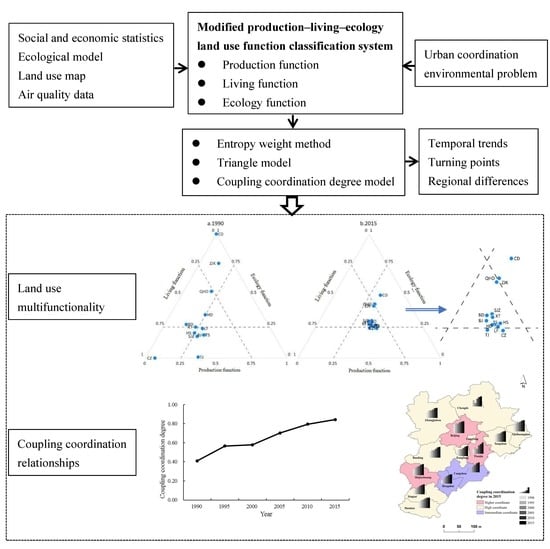Spatio-Temporal Coordination and Conflict of Production-Living-Ecology Land Functions in the Beijing-Tianjin-Hebei Region, China
Abstract
1. Introduction
2. Materials and Methods
2.1. Study Area
2.2. Production-Living-Ecology Land Use Function Classification System
2.3. Calculation Methods and Analysis Models
2.3.1. Weights and Evaluation for the Production-Living-Ecology Land Use Functions
2.3.2. Graphical Representation of Multifunctionality of Production-Living-Ecology Land Use Functions
2.3.3. Quantifying Production-Living-Ecology Land Use Functions Relationships Based on Coupling Coordination Degree Model
2.3.4. Assessing Spatial Advantageous Areas of Production-Living-Ecology Land Use Functions
3. Results
3.1. Temporal Patterns of Production-Living-Ecology Land Use Functions
3.2. Stages and Trends of Production-Living-Ecology Land Use Multifunctionality
3.3. Coupling Coordination Relationships among Production-Living-Ecology Land Use Functions
3.4. Advantageous Areas of Production-Living-Ecology Land Use Multifunctionality
4. Discussion
4.1. Insights into the Changes in the Production-Living-Ecology Land Use Functions
4.2. Similarities and Differences with Other Studies
4.3. Production-Living-Ecology Land Use Function Optimization and Research Directions
5. Conclusions
Author Contributions
Funding
Conflicts of Interest
References
- Foley, J.A.; DeFries, R.; Asner, G.P.; Barford, C.; Bonan, G.; Carpenter, S.R.; Chapin, F.S.; Coe, M.T.; Daily, G.C.; Gibbs, H.K.; et al. Global consequences of land use. Science 2005, 309, 570–574. [Google Scholar] [CrossRef]
- Mukul, S.A.; Saha, N. Conservation benefits of tropical multifunctional land-Uses in and around a forest protected area of Bangladesh. Land 2017, 6, 2. [Google Scholar] [CrossRef]
- Song, W.; Deng, X.Z. Land–use/land–cover change and ecosystem service provision in China. Sci. Total Environ. 2017, 576, 705–719. [Google Scholar] [CrossRef] [PubMed]
- De Groot, R. Function–analysis and valuation as a tool to assess land use conflicts in planning for sustainable, multi–functional landscapes. Landsc. Urban Plan. 2006, 75, 175–186. [Google Scholar] [CrossRef]
- Verburg, P.H.; Van De Steeg, J.; Veldkamp, A.; Willemen, L. From land cover change to land function dynamics: A major challenge to improve land characterization. J. Environ. Manag. 2009, 90, 1327–1335. [Google Scholar] [CrossRef]
- Lovell, S.T. Multifunctional urban agriculture for sustainable land use planning in the United States. Sustainability 2010, 2, 2499–2522. [Google Scholar] [CrossRef]
- Junior, R.F.V.; Varandas, S.G.P.; Pacheco, F.A.L.; Pereira, V.R.; Santos, C.F.; Cortes, R.M.V.; Fernandes, L.F.S. Impacts of land use conflicts on riverine ecosystems. Land Use Policy 2015, 43, 48–62. [Google Scholar] [CrossRef]
- De Groot, R. Functions of Nature: Evaluation of Nature in Environmental Planning, Management and Decision Making; Wolters–Noordhoff BV: Groningen, The Netherlands, 1992. [Google Scholar]
- De Groot, R.; Wilson, M.; Boumans, R. A typology for the description, classification and valuation of ecosystem functions, goods and services. Ecol. Econ. 2002, 41, 393–408. [Google Scholar] [CrossRef]
- Willemen, L.; Verburg, P.H.; Hein, L.; Mensvoort, M.E.F.V. Spatial characterization of landscape functions. Landsc. Urban Plan. 2008, 88, 34–43. [Google Scholar] [CrossRef]
- Liu, J.L.; Liu, Y.S.; Li, Y.R. Classification evaluation and spatial–temporal analysis of “production–living–ecological” spaces in China. Acta Geogr. Sin. 2017, 72, 1290–1304. (In Chinese) [Google Scholar]
- Liao, G.T.; He, P.; Gao, X.S.; Deng, L.J.; Zhang, H.; Feng, N.N.; Zhou, W.; Deng, O.P. The production–living–ecological land classification system and its characteristics in the hilly area of Sichuan province, southwest China based on identification of the main functions. Sustainability 2019, 11, 1600. [Google Scholar] [CrossRef]
- Zhang, H.Q.; Xu, E.Q.; Zhu, H.Y. Ecological–living–productive land classification system in China. J. Resour. Ecol. 2017, 8, 121–128. [Google Scholar]
- CPC Central Committee, State Council. The Rural Revitalization Strategic Plan (2018–2022). Available online: https://bit.ly/2TzfFJd (accessed on 22 May 2020).
- Tipraqsa, P.; Craswell, E.T.; Noble, A.D.; Schmidt-Vogt, D. Resource integration for multiple benefits: Multifunctionality of integrated farming systems in Northeast Thailand. Agric. Syst. 2007, 94, 694–703. [Google Scholar] [CrossRef]
- Song, X.Q.; Huang, Y.; Wu, Z.F.; Ouyang, Z. Does cultivated land function transition occur in China? J. Geogr. Sci. 2015, 25, 817–835. [Google Scholar] [CrossRef]
- Taleai, M.; Sharifi, A.; Sliuzas, R.; Mesgari, M. Evaluating the compatibility of multi–functional and intensive urban land uses. Int. J. Appl. Earth Obs. Geoinf. 2007, 9, 375–391. [Google Scholar] [CrossRef]
- Pérez–Soba, M.; Petit, S.; Jones, L.; Bertrand, N.; Briquel, V.; Omodei-Zorini, L.; Contini, C.; Helming, K.; Farrington, J.H.; Mossello, M.T.; et al. Land Use Functions—a Multifunctionality Approach to Assess the Impact of Land Use Changes on Land Use Sustainability//Sustainability Impact Assessment of Land Use Changes; Springer: Berlin/Heidelberg, Germany, 2008; pp. 375–404. [Google Scholar]
- Wiggering, H.; Dalchow, C.; Glemnitz, M.; Helming, K.; Müller, K.; Schultz, A.; Stachow, U.; Zander, P. Indicators for multifunctional land use—Linking socio–economic requirements with landscape potentials. Ecol. Indic. 2006, 6, 238–249. [Google Scholar] [CrossRef]
- Fan, Y.T.; Jin, X.B.; Gan, L. Spatial identification and dynamic analysis of land use functions reveals distinct zones of multiple functions in eastern China. Sci. Total Environ. 2018, 642, 33–44. [Google Scholar] [CrossRef] [PubMed]
- Zhang, Y.N.; Long, H.L.; Tu, S.S.; Ge, D.Z.; Ma, L.; Wang, L.Z. Spatial identification of land use functions and their tradeoffs/synergies in China: Implications for sustainable land management. Ecol. Indic. 2019, 107, 105550. [Google Scholar] [CrossRef]
- Costanza, R.; d’Arge, R.; De Groot, R.; Farber, S.; Grasso, M.; Hannon, B.; Limburg, K.; Naeem, S.; O’Neill, R.V.; Paruelo, J.; et al. The value of the world’s ecosystem services and natural capital. Nature 1997, 387, 253–260. [Google Scholar] [CrossRef]
- Gong, J.; Liu, D.Q.; Zhang, J.X.; Xie, Y.C.; Cao, E.J.; Li, H.Y. Tradeoffs/synergies of multiple ecosystem services based on land use simulation in a mountain–basin area, western China. Ecol. Indic. 2019, 99, 283–293. [Google Scholar] [CrossRef]
- Wang, S.J.; Ma, H.; Zhao, Y.B. Exploring the relationship between urbanization and the eco–environment—A case study of Beijing-Tianjin-Hebei region. Ecol. Indic. 2014, 45, 171–183. [Google Scholar] [CrossRef]
- Belmeziti, A.; Cherqui, F.; Kaufmann, B. Improving the multi–functionality of urban green spaces: Relations between components of green spaces and urban services. Sustain. Cities Soc. 2018, 43, 1–10. [Google Scholar] [CrossRef]
- Jiang, C.; Zhang, H.Y.; Zhang, Z.D. Spatially explicit assessment of ecosystem services in China’s Loess Plateau: Patterns, interactions, drivers, and implications. Glob. Planet. Chang. 2018, 161, 41–52. [Google Scholar] [CrossRef]
- Hermann, A.; Kuttner, M.; Hainz–Renetzeder, C.; Konkoly-Gyuró, É.; Tirászi, Á.; Brandenburg, C.; Allex, B.; Zienerc, K.; Wrbka, T. Assessment framework for landscape services in European cultural landscapes: An Austrian Hungarian case study. Ecol. Indic. 2014, 37, 229–240. [Google Scholar] [CrossRef]
- Stürck, J.; Verburg, P.H. Multifunctionality at what scale? A landscape multifunctionality assessment for the European Union under conditions of land use change. Landsc. Ecol. 2017, 32, 481–500. [Google Scholar] [CrossRef]
- Liu, C.; Xu, Y.Q.; Huang, A.; Liu, Y.X.; Wang, H.; Lu, L.H.; Sun, P.L.; Zheng, W.R. Spatial identification of land use multifunctionality at grid scale in farming–pastoral area: A case study of Zhangjiakou City, China. Habitat Int. 2018, 76, 48–61. [Google Scholar] [CrossRef]
- Peng, J.; Hu, X.X.; Qiu, S.J.; Hu, Y.N.; Meersmans, J.; Liu, Y.X. Multifunctional landscapes identification and associated development zoning in mountainous area. Sci. Total Environ. 2019, 660, 765–775. [Google Scholar] [CrossRef]
- Millennium Ecosystem Assessment. Ecosystems and Human Well-being; Island Press: Washington, DC, USA, 2005; pp. 1–10. [Google Scholar]
- Odum, H.T.; Odum, E.P. The energetic basis for valuation of research in Latin America: The state of the art. Ecosyst. Serv. 2012, 41, 7–10. [Google Scholar]
- Villa, F.; Bagstad, K.J.; Voigt, B.; Johnson, G.W.; Portela, R.; Honzak, M.; Batker, D. A methodology for adaptable and robust ecosystem services assessment. PLoS ONE 2014, 9, e91001. [Google Scholar] [CrossRef]
- Labiosa, W.B.; Forney, W.M.; Esnard, A.M.; Mitsova-Boneva, D.; Bernknopf, R.; Hearn, P.; Hogane, D.; Pearlstine, L.; Strong, D.; Gladwin, H.; et al. An integrated multi-criteria scenario evaluation web tool for participatory land-use planning in urbanized areas: The Ecosystem Portfolio Model. Environ. Model. Softw. 2013, 41, 210–222. [Google Scholar] [CrossRef]
- Cai, E.X.; Jing, Y.; Liu, Y.L.; Yin, C.H.; Gao, Y.; Wei, J.Q. Spatial–temporal patterns and driving forces of ecological–living–production land in Hubei province, Central China. Sustainability 2018, 10, 66. [Google Scholar] [CrossRef]
- Zhou, D.; Xu, J.C.; Lin, Z.L. Conflict or coordination? Assessing land use multi–functionalization using production-living-ecology analysis. Sci. Total Environ. 2016, 577, 136–147. [Google Scholar] [CrossRef] [PubMed]
- Peng, L.; Wang, X.X.; Chen, T.T. Multifunctional land–use value mapping and space type classification: A case study of Puge County, China. Nat. Resour. Modeling 2019, 32, 1–24. [Google Scholar] [CrossRef]
- Wang, L.Y.; Li, F.X.; Gong, Y.; Jiang, P.H.; Huang, Q.H.; Hong, W.Y.; Chen, D. A quality assessment of national territory use at the city level: A planning review perspective. Sustainability 2016, 8, 145. [Google Scholar] [CrossRef]
- Hao, S.Y. China’s path to the construction of low–carbon cities in the context of new–style urbanization. China Financ. Econ. Rev. 2014, 2, 3. [Google Scholar]
- Xiang, H.; Yang, Q.Y.; Su, K.C.; Zhang, Z.X. Spatiotemporal dynamics and obstacles of the multi–functionality of land use in Xiangxi, China. Appl. Sci. 2019, 9, 3649. [Google Scholar] [CrossRef]
- Pinto–Correia, T.; Vos, W. Multifunctionality in Mediterranean landscapes–past and future. New Dimens. Eur. Landsc. 2004, 4, 135–164. [Google Scholar]
- Thackway, R.; Freudenberger, D. Accounting for the drivers that degrade and restore landscape functions in Australia. Land 2016, 5, 40. [Google Scholar] [CrossRef]
- He, C.Y.; Zhang, D.; Huang, Q.X.; Zhao, Y.Y. Assessing the potential impacts of urban expansion on regional carbon storage by linking the LUSD–urban and InVEST models. Environ. Model. Softw. 2016, 75, 44–58. [Google Scholar] [CrossRef]
- Peng, J.; Chen, X.; Liu, Y.X.; Lu, H.L.; Hu, X.X. Spatial identification of multifunctional landscapes and associated influencing factors in the Beijing-Tianjin-Hebei Region, China. Appl. Geogr. 2016, 74, 170–181. [Google Scholar] [CrossRef]
- National Bureau of Statistics of China. China City Statistical Yearbook in 2016; China Statistics Press: Beijing, China, 2016. (In Chinese) [Google Scholar]
- Ministry of Environmental Protection of China. Bulletin on the State of the Environment of China in 2015; Ministry of Environmental Protection of China: Beijing, China, 2016. (In Chinese)
- Pasche, M. Technical progress, structural change, and the environmental Kuznets curve. Ecol. Econ. 2002, 42, 381–389. [Google Scholar] [CrossRef]
- CPC Central Committee, State Council. Beijing-Tianjin-Hebei Coordinated Development Plan Outline. 2015. Available online: https://bit.ly/2AWlvxZ (accessed on 22 May 2020).
- Carvalho, F.M.V.; Júnior, P.D.M.; Ferreira, L.G. The Cerrado into–pieces: Habitat fragmentation as a function of landscape use in the savannas of central Brazil. Biol. Conserv. 2009, 142, 1392–1403. [Google Scholar] [CrossRef]
- Geneletti, D. Using spatial indicators and value functions to assess ecosystem fragmentation caused by linear infrastructures. Int. J. Appl. Earth Obs. Geoinf. 2004, 5, 1–15. [Google Scholar] [CrossRef]
- Tallis, H.T.; Ricketts, R.T.; Guerry, A.D. InVEST 2.6.0 User’s Guide: Integrated Valuation of Environmental Services and Tradeoffs; The Natural Capital Project: Stanford, CA, USA, 2014. [Google Scholar]
- Terrado, M.; Sabater, S.; Chaplin–Kramer, B.; Mandle, L.; Ziv, G.; Acuñaa, V. Model development for the assessment of terrestrial and aquatic habitat quality in conservation planning. Sci. Total Environ. 2016, 540, 63–70. [Google Scholar] [CrossRef]
- Shannon, C.E. Communication theory of secrecy systems. Bell Syst. Tech. J. 1948, 28, 656–715. [Google Scholar] [CrossRef]
- Smalley, L.L.; Woosley, J.K. Application of steady state maximum entropy methods to high kinetic energy impacts on ceramic targets. Int. J. Impact Eng. 1999, 23, 869–882. [Google Scholar] [CrossRef]
- Amiri, V.; Rezaei, M.; Sohrabi, N. Groundwater quality assessment using entropy weighted water quality index (EWQI) in Lenjanat, Iran. Environ. Earth Sci. 2014, 72, 3479–3490. [Google Scholar] [CrossRef]
- Yolcubal, I.; Brusseau, M.L.; Artiola, J.F.; Wierenga, P.; Wilson, L.G. Environmental Physical Properties and Processes. In Environmental Monitoring and Characterization; Elsevier Inc.: Amsterdam, The Netherlands, 2004; pp. 207–239. [Google Scholar]
- Xu, F.L.; Zhao, S.S.; Dawson, R.W.; Hao, J.Y.; Zhang, Y.; Tao, S. A triangle model for evaluating the sustainability status and trends of economic development. Ecol. Model. 2006, 195, 327–337. [Google Scholar] [CrossRef]
- Peng, J.; Liu, Z.C.; Liu, Y.X.; Hu, X.X.; Wang, A. Multifunctionality assessment of urban agriculture in Beijing City, China. Sci. Total Environ. 2015, 537, 343–351. [Google Scholar] [CrossRef]
- Deng, F.M.; Fang, Y.; Xu, L.; Li, Z. Tourism, transportation and low-carbon city system coupling coordination degree: A case study in Chongqing Municipality, China. Int. J. Environ. Res. Public Health 2020, 17, 792. [Google Scholar] [CrossRef]
- Shi, T.; Yang, S.Y.; Zhang, W.; Zhou, Q. Coupling coordination degree measurement and spatiotemporal heterogeneity between economic development and ecological environment––––Empirical evidence from tropical and subtropical regions of China. J. Clean. Prod. 2020, 244, 118739. [Google Scholar] [CrossRef]
- Wu, X. A New Stage of Reform, Opening Up, and Development (1992–1998). In Contemporary Chinese Rural Reform; Springer: Berlin/Heidelberg, Germany, 2016; pp. 191–233. [Google Scholar]
- Wang, L.; Li, C.C.; Ying, Q.; Cheng, X.; Wang, X.Y.; Li, X.Y.; Hu, L.Y.; Liang, L.; Yu, L.; Huang, H.B.; et al. China’s urban expansion from 1990 to 2010 determined with satellite remote sensing. Chin. Sci. Bull. 2012, 57, 2802–2812. [Google Scholar] [CrossRef]
- Yang, Y. Brief Analysis of China’s Economic Situation and Trend Forecast//2018 2nd International Conference on Education Science and Economic Management (ICESEM 2018); Atlantis Press: Paris, France, 2018. [Google Scholar]
- Yu, D.L. Understanding regional development mechanisms in Greater Beijing Area, China, 1995–2001, from a spatial–temporal perspective. GeoJournal 2014, 79, 195–207. [Google Scholar] [CrossRef]
- Zhang, Q.; Yu, H.Q.; Sun, P.; Singh, V.P.; Shi, P.J. Multisource data based agricultural drought monitoring and agricultural loss in China. Glob. Planet. Chang. 2019, 172, 298–306. [Google Scholar] [CrossRef]
- Wang, M.M.; Lu, T.F.; Zhang, D.L. Rational development and optimal allocation of water resources in Chengde. Hebei Water Conserv. 2005, 8, 17–18. (In Chinese) [Google Scholar]
- Liu, M.; Wei, J.H.; Wang, G.Q.; Wang, F. Water resources stress assessment and risk early warning–a case of Hebei Province China. Ecol. Indic. 2017, 73, 358–368. [Google Scholar] [CrossRef]
- Wang, X.K.; Dong, Z.C.; Xu, W.; Luo, Y.; Zhou, T.; Wang, W.Z. Study on spatial and temporal distribution characteristics of coordinated development degree among regional water resources, social economy, and ecological environment systems. Int. J. Environ. Res. Public Health 2019, 16, 4213. [Google Scholar] [CrossRef] [PubMed]
- Yang, D.T. Urban-biased policies and rising income inequality in China. Am. Econ. Rev. 1999, 89, 306–310. [Google Scholar] [CrossRef]
- Hertel, T.; Zhai, F. Labor market distortions, rural–urban inequality and the opening of China’s economy. Econ. Model. 2006, 23, 76–109. [Google Scholar] [CrossRef]
- Zhang, Y.; Qi, H. Research on the evaluation of sustainable development in Cangzhou City based on Neural-Network-AHP. In Proceedings of the 2006 International Conference on Machine Learning and Cybernetics, Dalian, China, 13–16 August 2006; pp. 3144–3147. [Google Scholar]
- Cerreta, M.; Poli, G. Landscape services assessment: A hybrid multi–criteria spatial decision support system (MC–SDSS). Sustainability 2017, 9, 1311. [Google Scholar] [CrossRef]
- Far, S.T.; Rezaei–Moghaddam, K. Multifunctional agriculture: An approach for entrepreneurship development of agricultural sector. J. Glob. Entrep. Res. 2019, 9, 23. [Google Scholar]
- Ochola, W.O.; Kerkides, P. An integrated indicator–based spatial decision support system for land quality assessment in Kenya. Comput. Electron. Agric. 2004, 45, 3–26. [Google Scholar] [CrossRef]
- Zhao, M.X.; Wei, J.M.; Wu, K. Functional relationship and complex network evolution of Beijing-Tianjin-Hebei urban agglomeration. J. Urban Plan. 2014, 1, 47–52. (In Chinese) [Google Scholar]
- Han, B.L.; Liu, H.X.; Wang, R.S. Urban ecological security assessment for cities in the Beijing-Tianjin-Hebei metropolitan region based on fuzzy and entropy methods. Ecol. Model. 2019, 318, 217–225. [Google Scholar] [CrossRef]
- United Nations. Transforming Our World: The 2030 Agenda for Sustainable Development; Working Papers; United Nations: New York, NY, USA, 2015; p. 14. [Google Scholar]
- Fang, C.L. Theoretical foundation and patterns of coordinated development of the Beijing-Tianjin-Hebei urban agglomeration. Prog. Geogr. 2017, 36, 15–24. [Google Scholar]
- Huang, J.; Yang, X. Urbanization quality evaluation and strategy research of Hebei province. In Proceedings of the 2018 5th International Conference on Industrial Economics System and Industrial Security Engineering (IEIS), Toronto, ON, Canada, 3–6 August 2018; IEEE: Piscataway, NJ, USA, 2018; pp. 1–6. [Google Scholar]
- Chang, I.C.C.; Leitner, H.; Sheppard, E. A green leap forward? Eco–state restructuring and the Tianjin–Binhai eco–city model. Reg. Stud. 2016, 50, 929–943. [Google Scholar] [CrossRef]
- Todd, D. Changing technology, economic growth and port development: The transformation of Tianjin. Geoforum 1994, 25, 285–303. [Google Scholar] [CrossRef]
- Pollard, S.J.T.; Davies, G.J.; Coley, F.; Lemon, M. Better environmental decision making—recent progress and future trends. Sci. Total Environ. 2008, 400, 20–31. [Google Scholar] [CrossRef]
- Brown, I.; Castellazzi, M. Scenario analysis for regional decision–making on sustainable multifunctional land uses. Reg. Environ. Chang. 2014, 14, 1357–1371. [Google Scholar] [CrossRef]
- Xie, H.L.; He, Y.F.; Xie, X. Exploring the factors influencing ecological land change for China’s Beijing-Tianjin-Hebei region using big data. J. Clean. Prod. 2017, 142, 677–687. [Google Scholar] [CrossRef]
| 1 | In the National Land Uses Plan Outline (2006–2020) issued in 2008, the Chinese government began to emphasize the importance of the “production-living-ecology” land use planning. Then the Rural Revitalization Strategic Plan (2018–2022) issued in 2018 pointed out the need to “optimize production space, reasonably distribute living space, and protect ecological space.” |
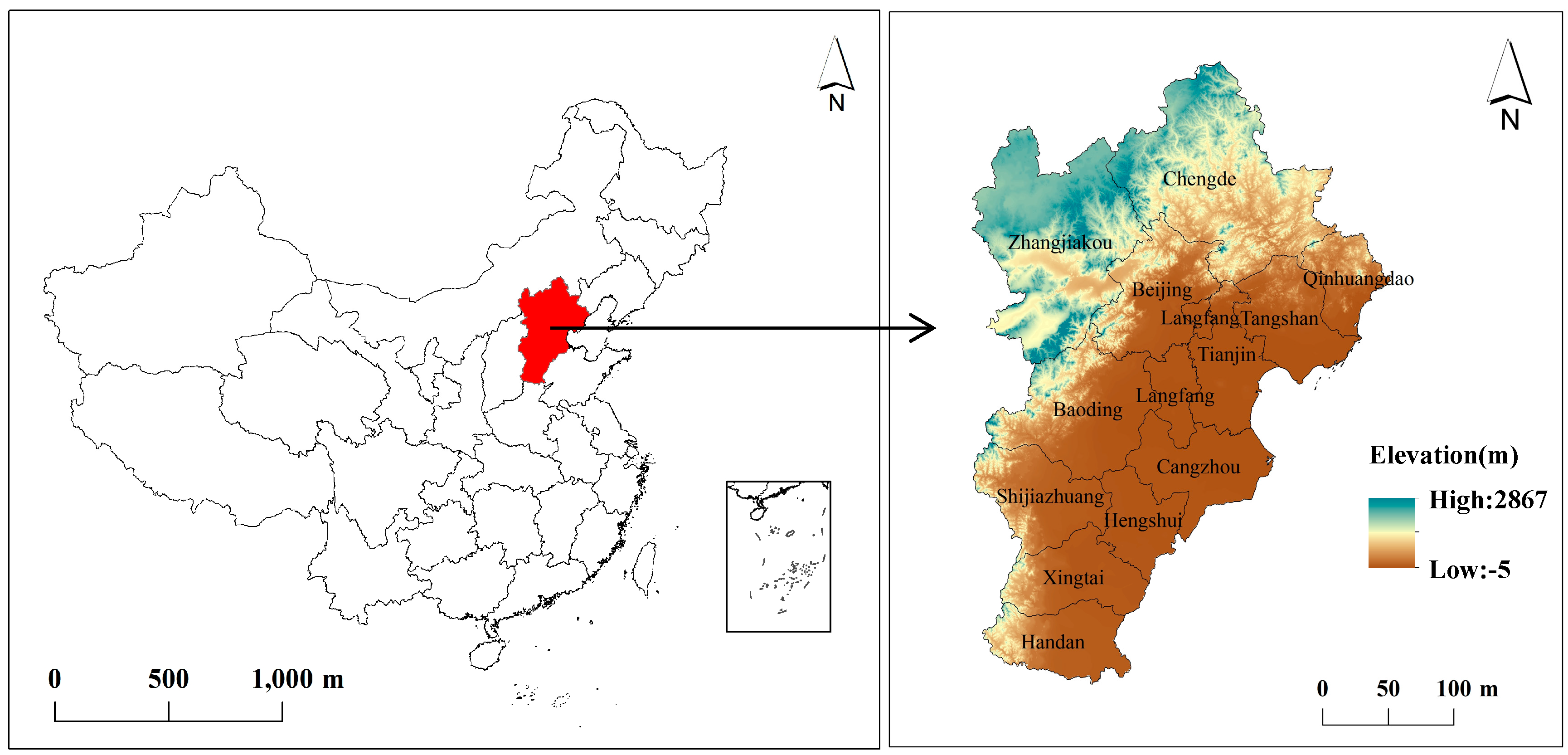
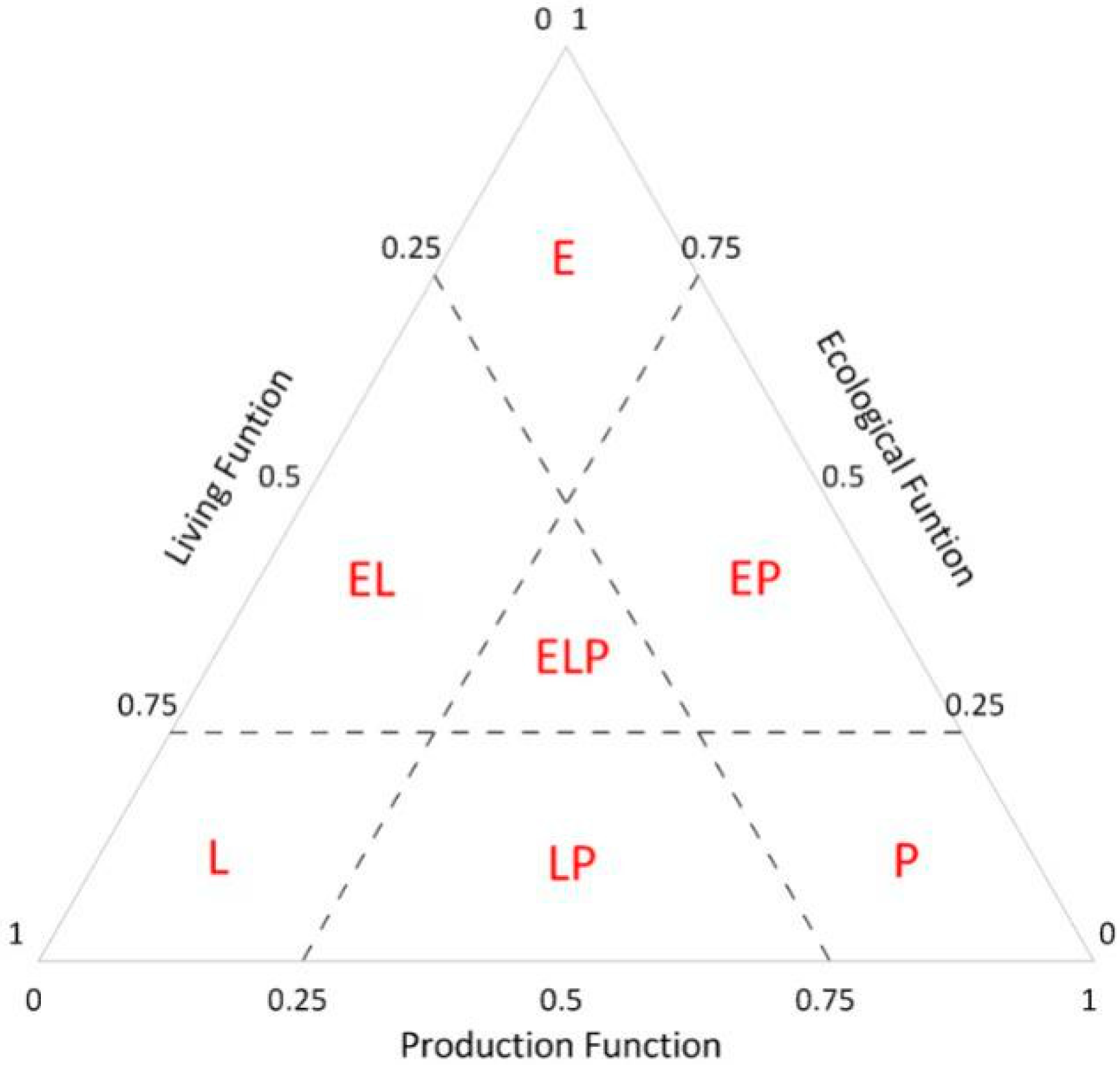
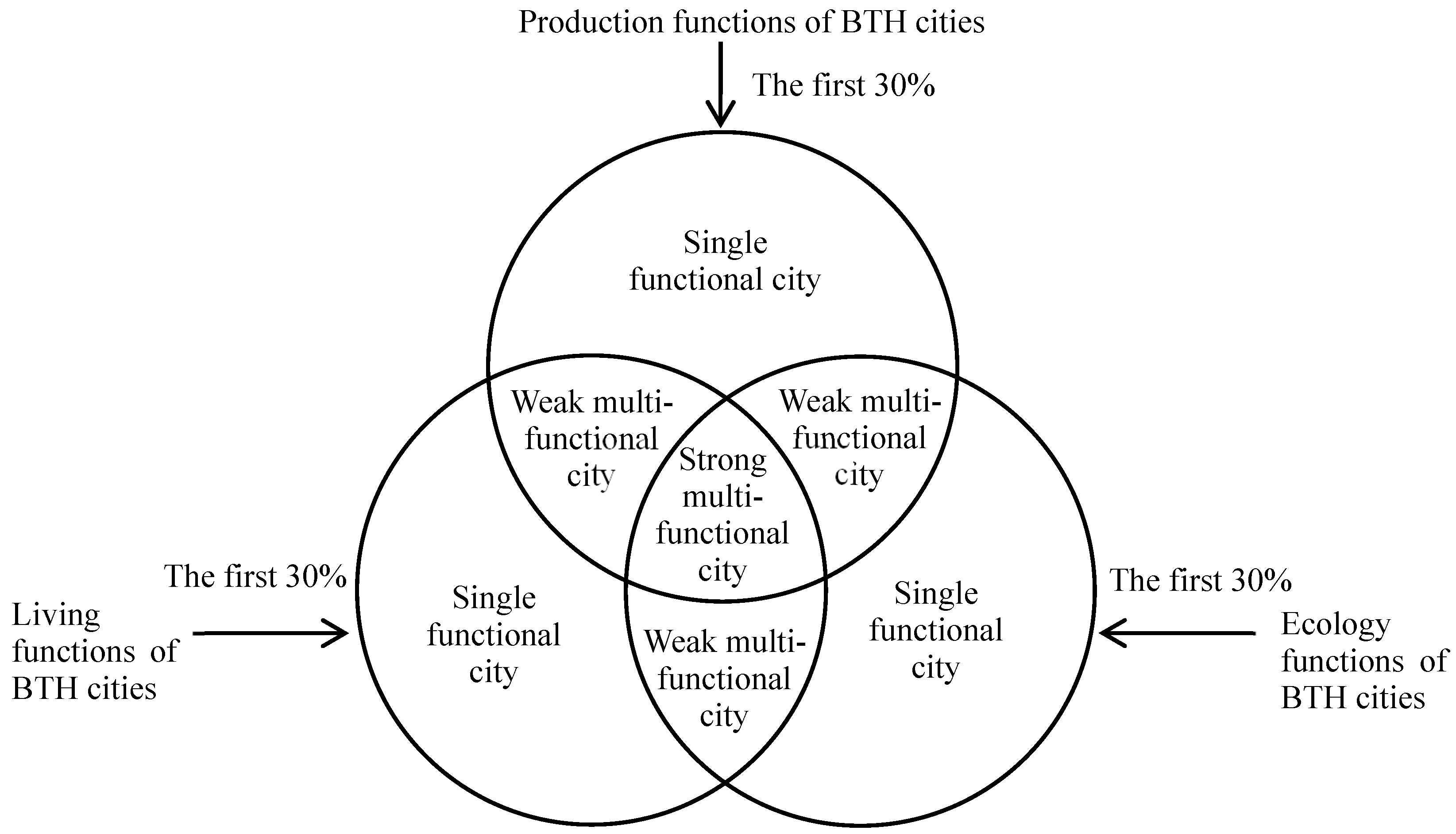

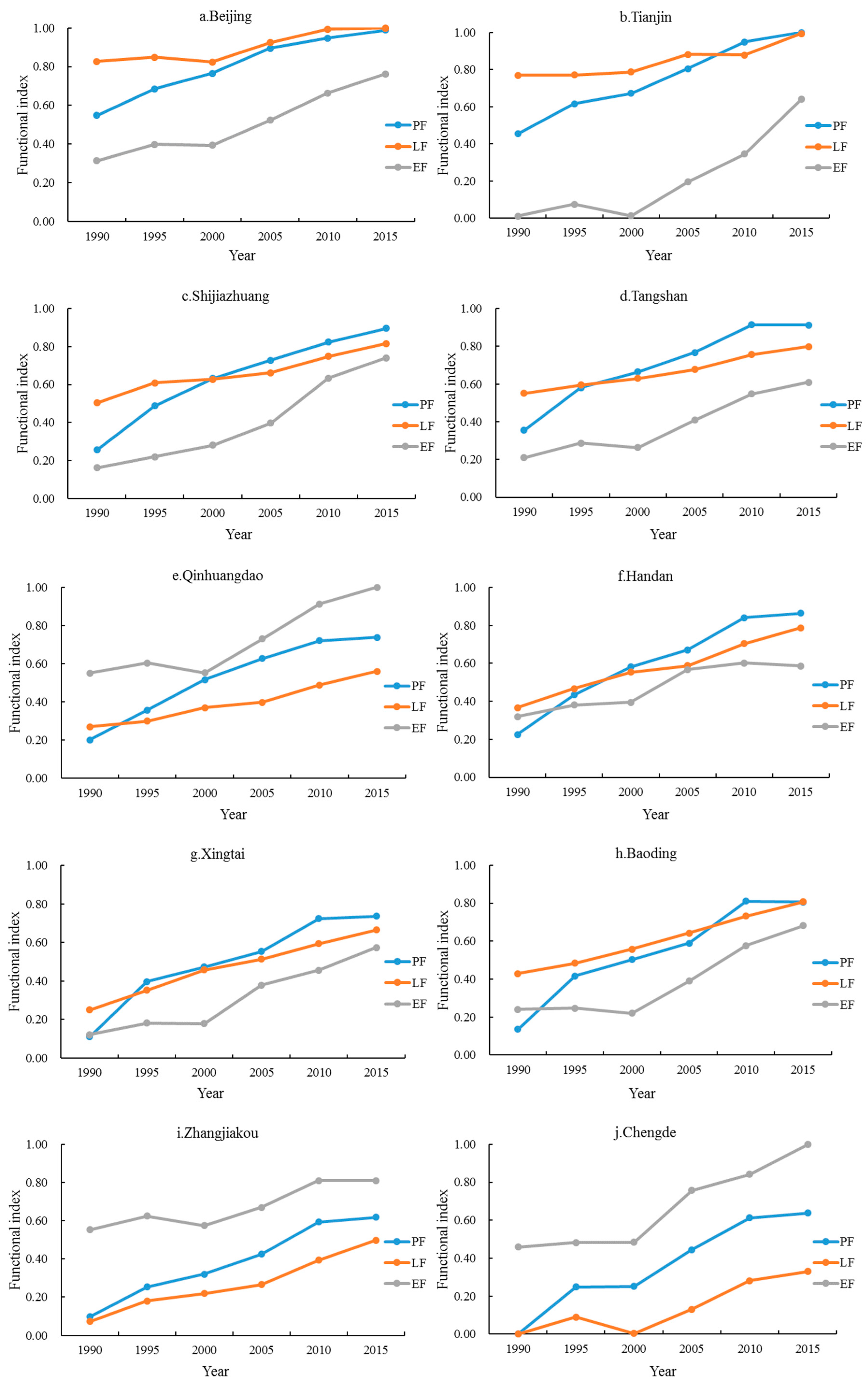
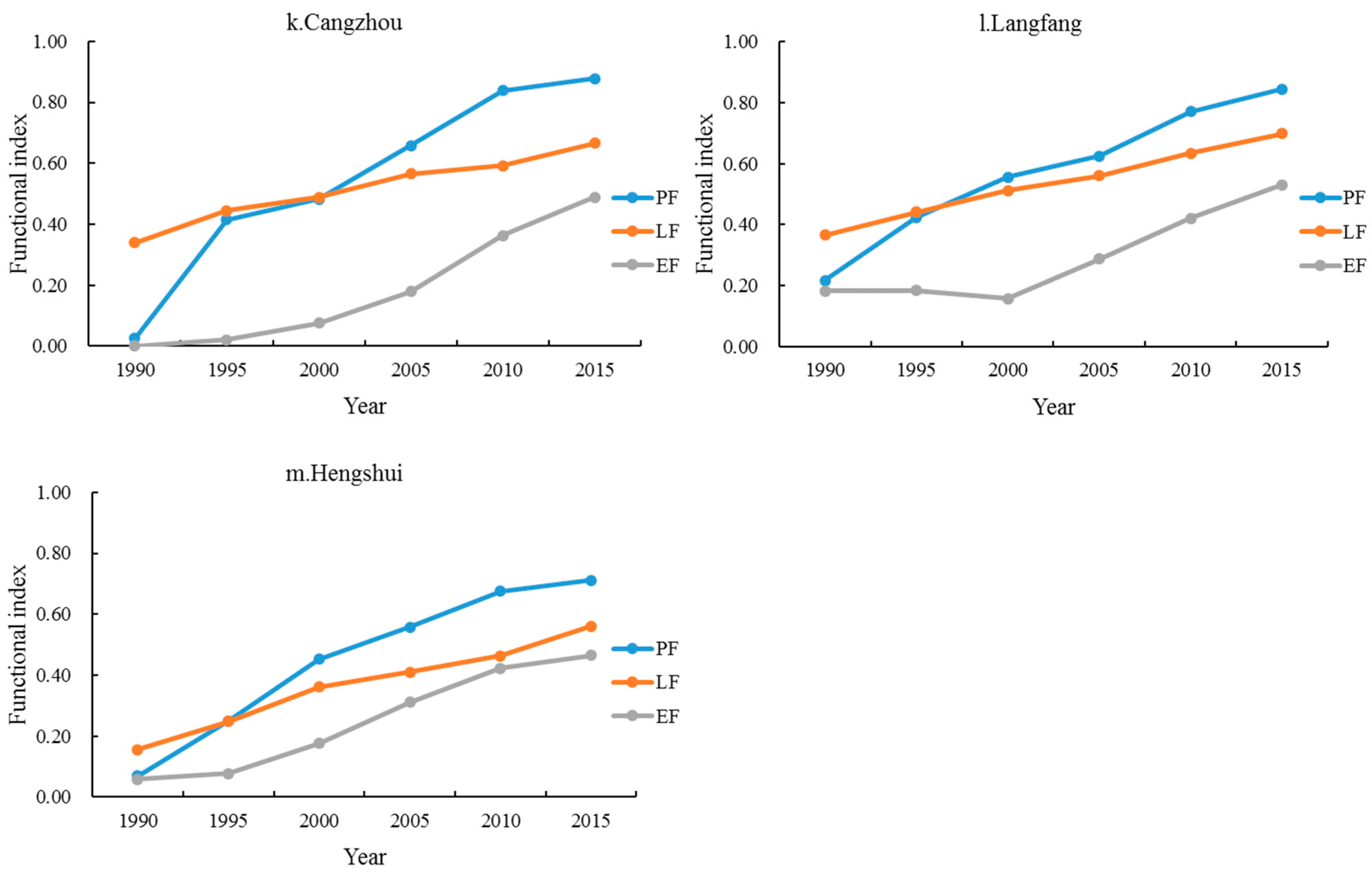

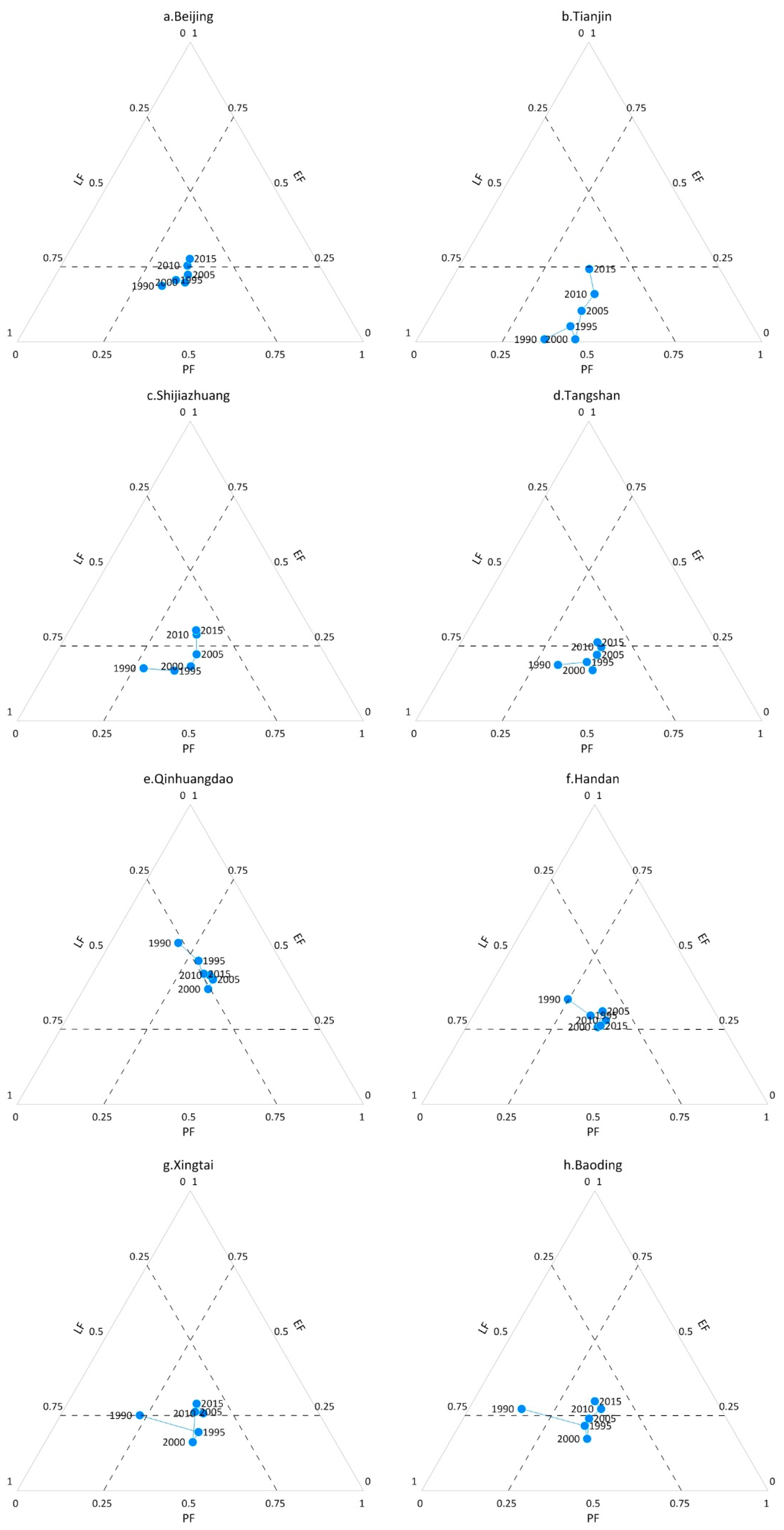
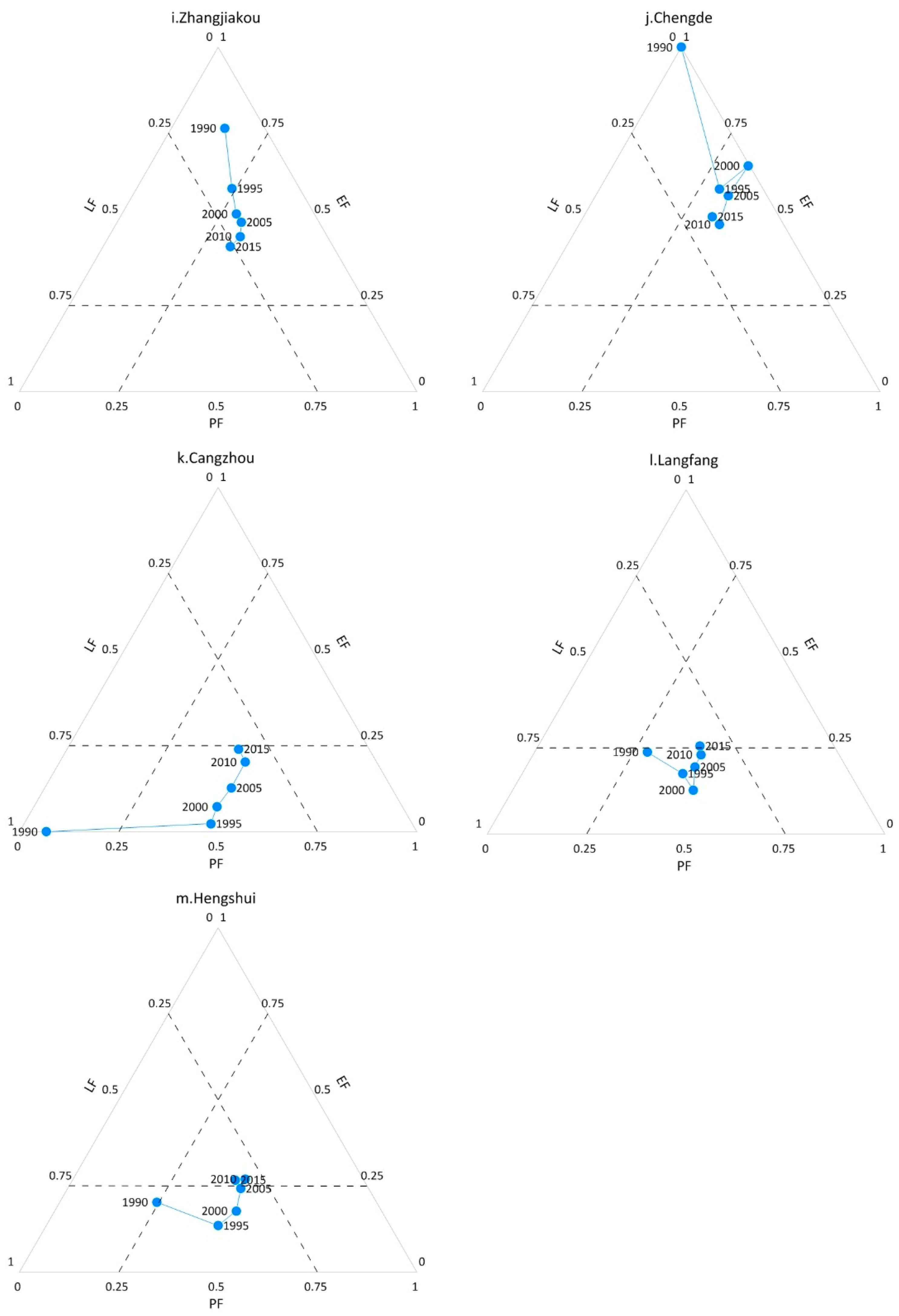
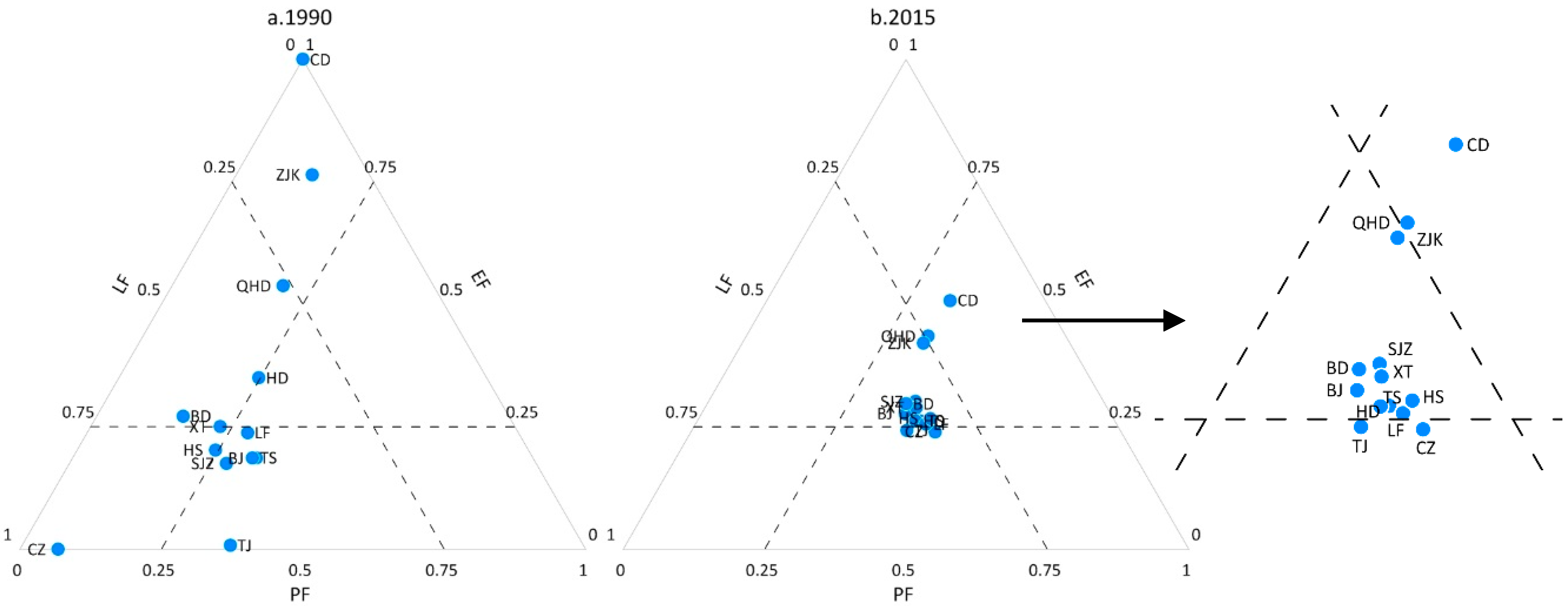
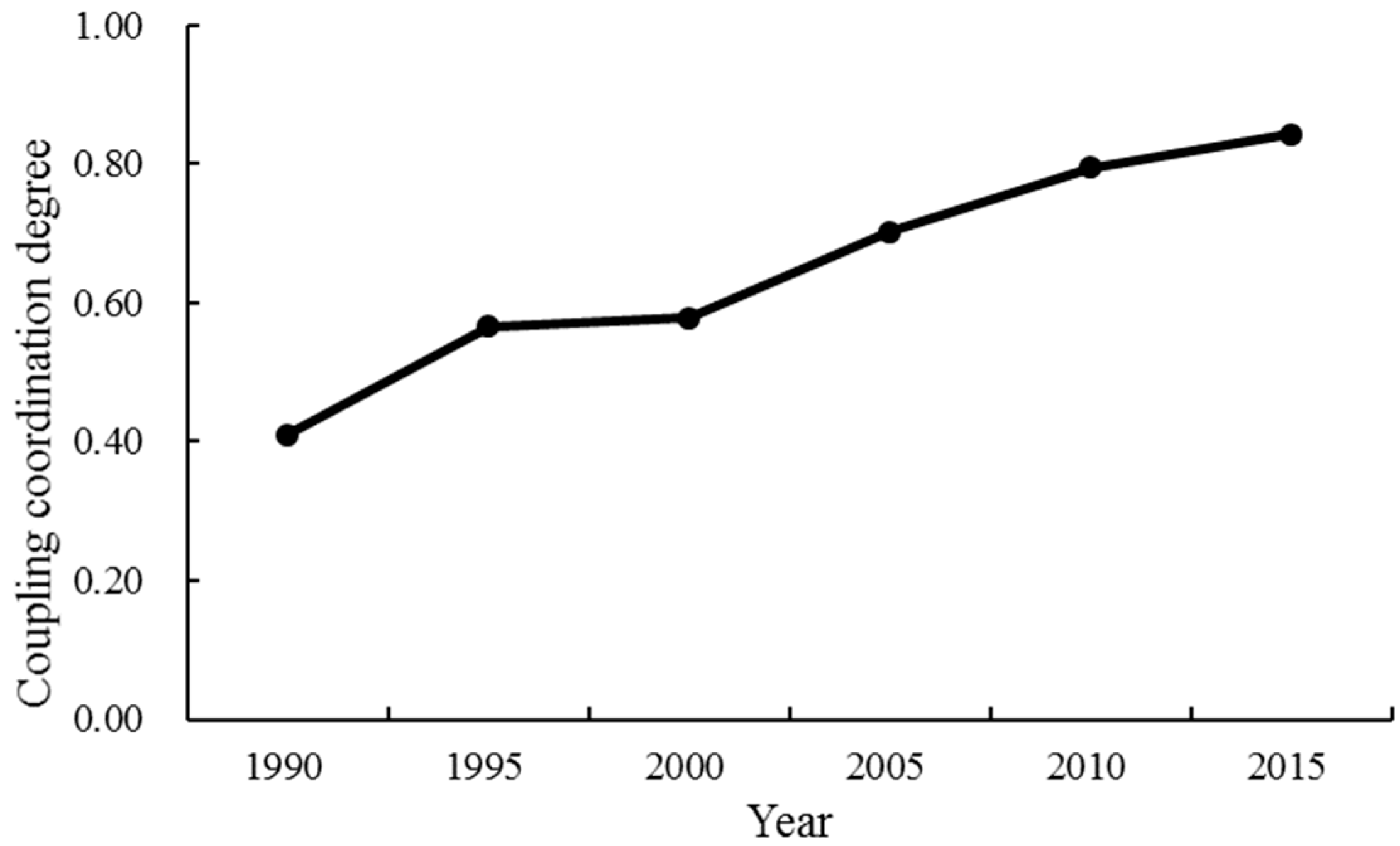
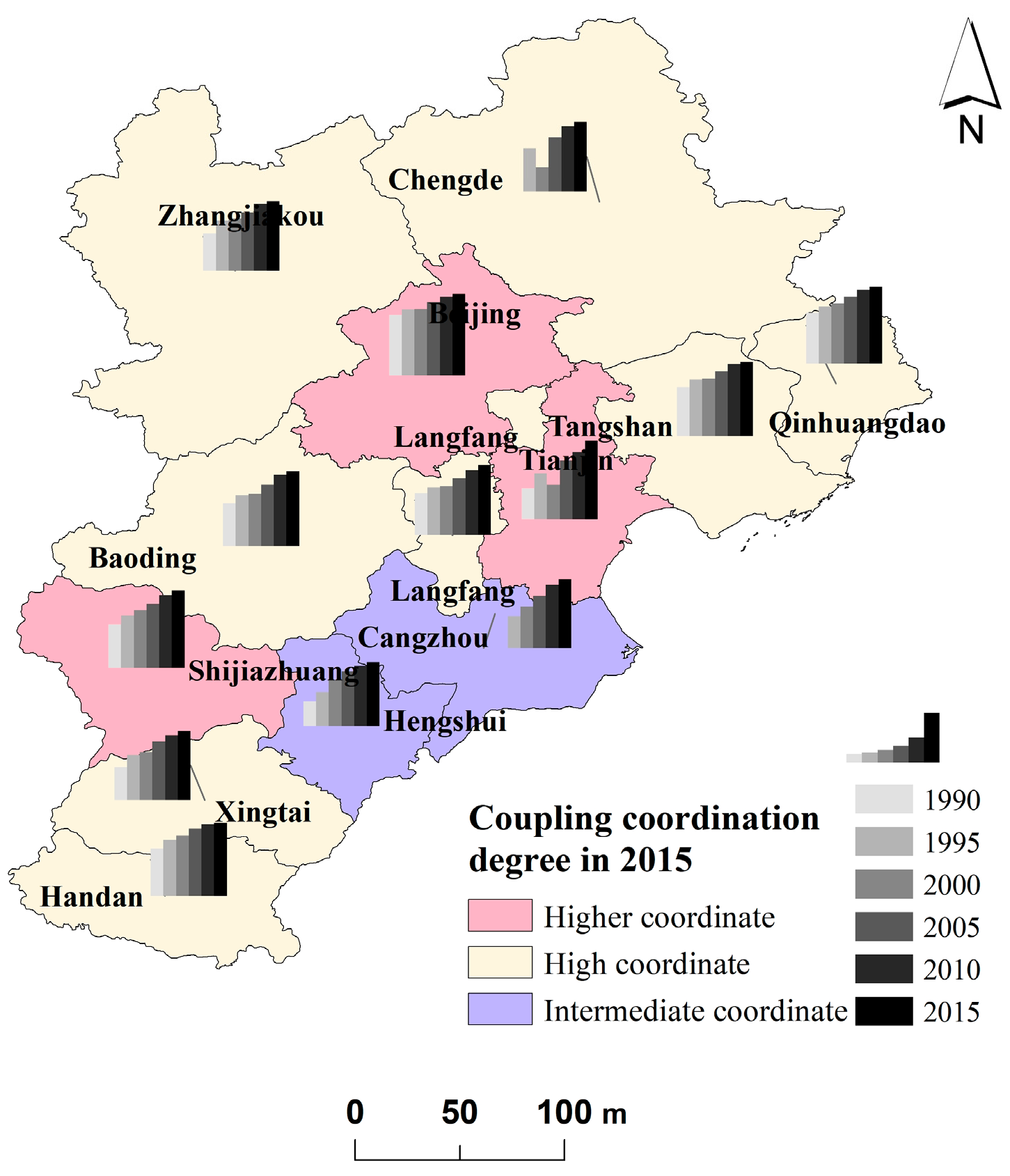
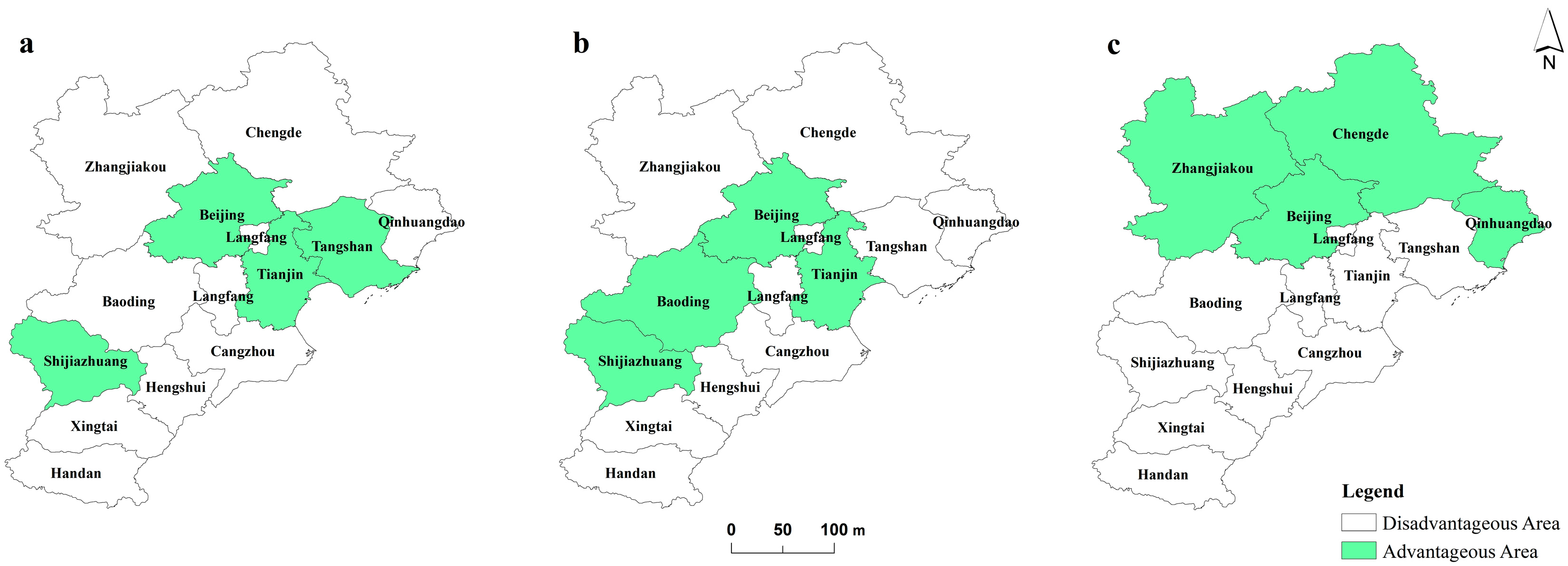
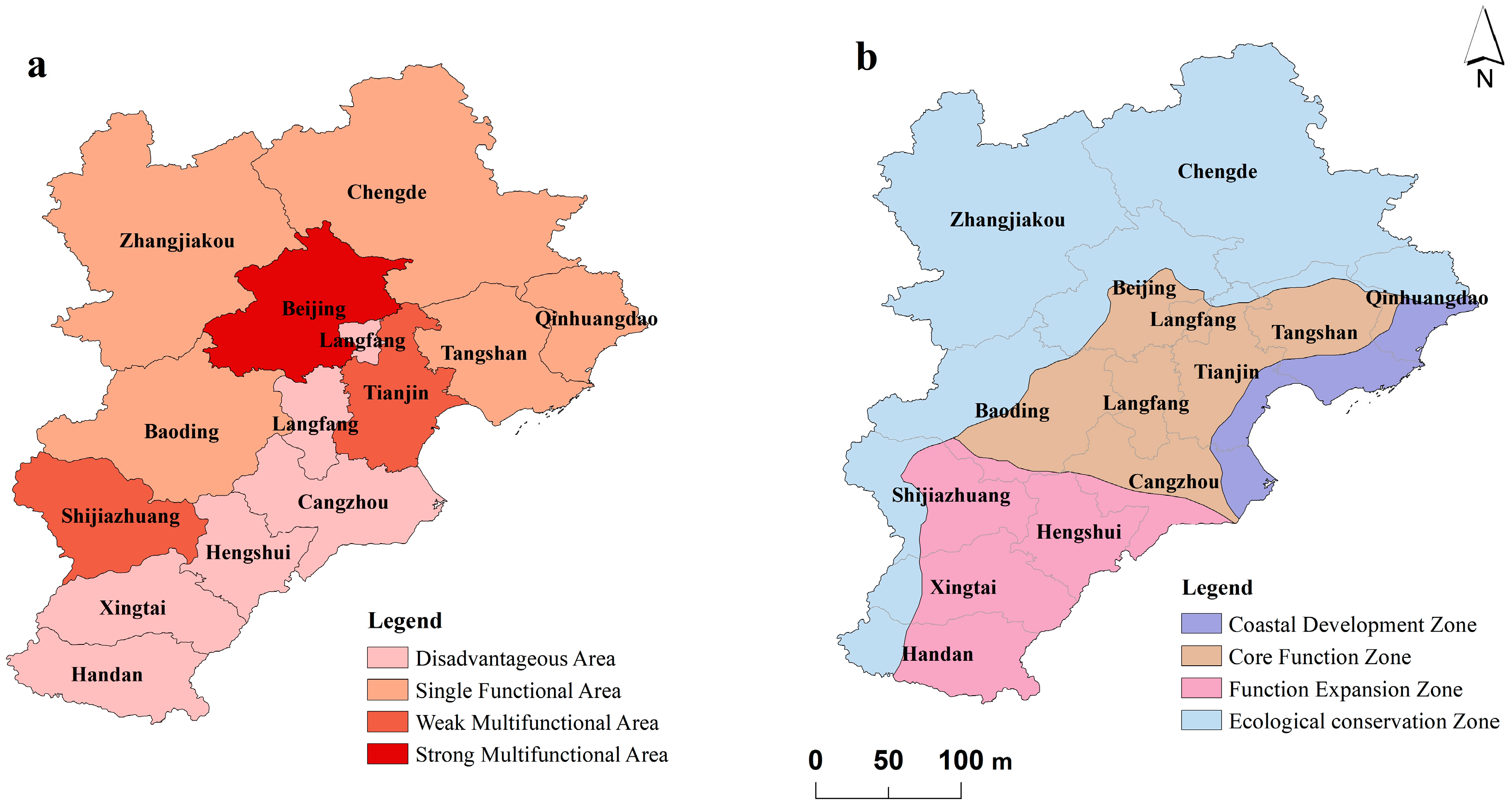
| Land Use Functions | Sub–Functions | Indicators | Unit | Calculation Methods |
|---|---|---|---|---|
| Production function | Agricultural production function | Grain yield per area | kg ha−1 | Total grain yield/grain sown area |
| Agricultural output values per area | RMB 10,000 km−2 | Total output values of agriculture, forestry, pasturage, and fishery/total land area | ||
| Economic development function | Industry output values per area | Billion RMB km−2 | Total industrial output value/total land area | |
| GDP per capita | RMB per capita−1 | Gross domestic product/population | ||
| Transportation function | Total freight volume | 10,000 tons | – | |
| Total passenger transport | 10,000 people | – | ||
| Living function | Habitat function | Permanent population density | Capita km−2 | Permanent population/total land area |
| Construction land area per capita | 10,000 km2 per capita−1 | Construction land area/population | ||
| Social security function | Urbanization level | Percent | Urban population /permanent population | |
| Rural-urban income gap | – | Urban disposable incomes/rural net incomes | ||
| Employment support function | Employed persons | 10,000 people | – | |
| Medical and educational function | Number of beds in hospitals | 10000 beds | – | |
| Number of college students | 10,000 people | – | ||
| Ecology function | Resources supply function | Total water resources per capita | m3 per capita−1 | Total water resources/population |
| Ecology regulation function | Centralized treatment rate of sewage treatment plant | Percent | Treated sewage /total sewage discharge | |
| Comprehensive utilization rate of general industrial solid waste | Percent | Comprehensive utilization of industrial solid waste/ total amount of industrial solid waste | ||
| PM10 | μg/m3 | – | ||
| Ecology maintenance function | Green coverage in constructed areas | Percent | Green coverage area/construction land area | |
| Pathological degree of ecosystem risk | – | Patch number/total area | ||
| Habitat quality | – | InVEST |
| Coupling Coordination Degree | Level |
|---|---|
| 0.0–0.09 | Higher conflict |
| 0.1–0.19 | High conflict |
| 0.2–0.29 | Intermediate conflict |
| 0.3–0.39 | Low conflict |
| 0.4–0.49 | Slight conflict |
| 0.5–0.59 | Barely coordinate |
| 0.6–0.69 | Low coordinate |
| 0.7–0.79 | Intermediate coordinate |
| 0.8–0.89 | High coordinate |
| 0.9–1.00 | Higher coordinate |
| City | 1990 | 1995 | 2000 | 2005 | 2010 | 2015 |
|---|---|---|---|---|---|---|
| Beijing | (0.32, 0.49, 0.19) | (0.35, 0.44, 0.21) | (0.38, 0.42, 0.20) | (0.38, 0.39, 0.23) | (0.37, 0.38, 0.25) | (0.36, 0.36, 0.28) |
| Tianjin | (0.37, 0.62, 0.01) | (0.42, 0.53, 0.05) | (0.46, 0.53, 0.01) | (0.43, 0.47, 0.10) | (0.44, 0.40, 0.16) | (0.38, 0.38, 0.24) |
| Shijiazhuang | (0.27, 0.55, 0.18) | (0.37, 0.46, 0.17) | (0.41, 0.41, 0.18) | (0.41, 0.37, 0.22) | (0.37, 0.34, 0.29) | (0.37, 0.33, 0.30) |
| Tangshan | (0.32, 0.49, 0.19) | (0.40, 0.40, 0.20) | (0.43, 0.40, 0.17) | (0.41, 0.37, 0.22) | (0.41, 0.34, 0.25) | (0.40, 0.34, 0.26) |
| Qinhuangdao | (0.20, 0.26, 0.54) | (0.28, 0.24, 0.48) | (0.36, 0.26, 0.38) | (0.35, 0.23, 0.42) | (0.34, 0.23, 0.43) | (0.32, 0.24, 0.44) |
| Handan | (0.25, 0.40, 0.35) | (0.34, 0.36, 0.30) | (0.38, 0.36, 0.26) | (0.37, 0.32, 0.31) | (0.39, 0.33, 0.28) | (0.39, 0.35, 0.26) |
| Xingtai | (0.23, 0.52, 0.25) | (0.43, 0.38, 0.19) | (0.43, 0.41, 0.16) | (0.39, 0.35, 0.26) | (0.41, 0.33, 0.26) | (0.37, 0.34, 0.29) |
| Baoding | (0.15, 0.58, 0.27) | (0.36, 0.42, 0.22) | (0.39, 0.44, 0.17) | (0.36, 0.40, 0.24) | (0.38, 0.35, 0.27) | (0.35, 0.35, 0.30) |
| Zhangjiakou | (0.13, 0.10, 0.77) | (0.24, 0.17, 0.59) | (0.29, 0.20, 0.51) | (0.31, 0.20, 0.49) | (0.33, 0.22, 0.45) | (0.32, 0.26, 0.42) |
| Chengde | (0.00, 0.00, 1.00) | (0.30, 0.11, 0.59) | (0.34, 0.00, 0.66) | (0.33, 0.10, 0.57) | (0.35, 0.16, 0.49) | (0.32, 0.17, 0.51) |
| Cangzhou | (0.07, 0.93, 0.00) | (0.47, 0.51, 0.02) | (0.46, 0.47, 0.07) | (0.47, 0.40, 0.13) | (0.47, 0.33, 0.20) | (0.43, 0.33, 0.24) |
| Langfang | (0.28, 0.48, 0.24) | (0.40, 0.42, 0.18) | (0.45, 0.42, 0.13) | (0.42, 0.38, 0.20) | (0.42, 0.35, 0.23) | (0.40, 0.34, 0.26) |
| Hengshui | (0.24, 0.55, 0.21) | (0.43, 0.43, 0.14) | (0.45, 0.37, 0.18) | (0.44, 0.32, 0.24) | (0.43, 0.30, 0.27) | (0.41, 0.32, 0.27) |
© 2020 by the authors. Licensee MDPI, Basel, Switzerland. This article is an open access article distributed under the terms and conditions of the Creative Commons Attribution (CC BY) license (http://creativecommons.org/licenses/by/4.0/).
Share and Cite
Yu, Z.; Xu, E.; Zhang, H.; Shang, E. Spatio-Temporal Coordination and Conflict of Production-Living-Ecology Land Functions in the Beijing-Tianjin-Hebei Region, China. Land 2020, 9, 170. https://doi.org/10.3390/land9050170
Yu Z, Xu E, Zhang H, Shang E. Spatio-Temporal Coordination and Conflict of Production-Living-Ecology Land Functions in the Beijing-Tianjin-Hebei Region, China. Land. 2020; 9(5):170. https://doi.org/10.3390/land9050170
Chicago/Turabian StyleYu, Zhuxiao, Erqi Xu, Hongqi Zhang, and Erping Shang. 2020. "Spatio-Temporal Coordination and Conflict of Production-Living-Ecology Land Functions in the Beijing-Tianjin-Hebei Region, China" Land 9, no. 5: 170. https://doi.org/10.3390/land9050170
APA StyleYu, Z., Xu, E., Zhang, H., & Shang, E. (2020). Spatio-Temporal Coordination and Conflict of Production-Living-Ecology Land Functions in the Beijing-Tianjin-Hebei Region, China. Land, 9(5), 170. https://doi.org/10.3390/land9050170





